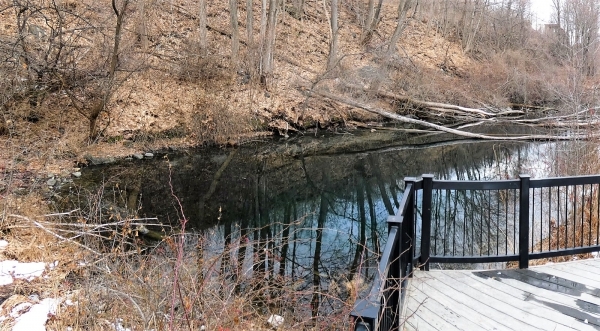BRATTLEBORO — The Vermont Board of Libraries has unanimously approved new names for two natural features located in Rockingham.
The first, Cold Springs, is a pond in the village of Bellows Falls.
The second was, Guild Brook, in the village of Cambridgeport.
The board is the department charged with naming geographic place names such as streams, mountains, and ponds.
According to its website, the board requires a petition signed by at least 25 people or from an administrative department of the state. The board gives preference to names that reflect “historical events, historic persons and flora and fauna native to Vermont, names characteristic to Vermont and its traditions.”
Peter Bergstrom of the Rockingham Conservation Committee organized the geographic naming petition for Cold Spring. He also helped Richard Cowan organize the petition to name Guild Brook.
Cold Springs - approximately 0.25 acres and 0.05 miles long - is located within the Bellows Falls Historic Riverfront Park and Trail system.
According to the petition, the spring-fed pond, on Mill Street near the wastewater treatment plant, rarely freezes in the winter, attracting birds throughout the colder months.
Approximately half the pond is located on the park land owned by the Bellows Falls Historical Society. The other half is located within the state's railroad right-of-way.
The Historical Society received nearly $1 million in brownfields grant money from the U.S. Environmental Protection Agency to clean up the 9-acre site, which had previously housed multiple mills.
Bergstrom was working with Historical Society to add interpretive signage to the Riverfront Park on Mill Street.
While working on a kiosk in the park, Bergstrom realized he didn't know what the nearby pond was called. The Historical Society found the pond referenced as Cold Springs in Frances Stockwell Lovell's 1958 History of the Town of Rockingham Vermont, he said.
“Not in the index - they must have read the whole darn thing,” he said.
According to him, the pond started as a spring and was later dug out to hold water. Its observation deck helps keep people out of the water, which has been contaminated from industrial use nearby.
Cowan lives along part of the waterway now called Guild Brook.
According to his petition, the 1.5-mile brook runs along the east side of Atcherson Hollow Road in Cambridgeport. It eventually feeds into Weaver Brook.
The name “Guild Brook” was chosen to honor Malcom “Mac” Guild, who died in 2014.
A 1952 graduate of Rutland High School, Guild attended Yale University on an ROTC scholarship. He later worked in information technology at IBM and the Fellows Gear Shaper Company in Springfield.
He and his wife Mary moved to a small farm along Atcherson Hollow Road in 1965. Two of the couple's children still live nearby.
Described as “a devoted nature lover and hiker,” Guild worked with the Vermont Land Trust in 2012 to conserve 113 acres of land within the brook's watershed.
A few months after Guild died, Cowan approached Bergstrom, who told him the state's naming process required a person be dead for at least five years before a natural feature can be named after them.
The board's policies also require that the person being honored have either strong ties to the feature or have made a significant contribution to the area or state.
“The idea is that right after someone dies you are too emotional and you should have some time to gain perspective,” Bergstrom said. “It didn't used to be a rule that the person had to be dead, so they named some features after some living people... and they went on to do some things that were not quite worthy of honor.”
By requiring that they be dead, “at least they can't do anything bad,” Bergstrom added.
Bergstrom and Cowan started their geographic naming petitions in January. Volunteers collected the required signatures at Annual Town Meeting in March.
The pandemic put the process on hold, and the original petitions were then lost inside Town Hall until the Town Clerk found them, he said.
Bergstrom views naming streams and other natural features as a way to engage a community in its environment and hopefully care for the land.
“Naming can promote stewardship, especially if it raises awareness,” he said.
While living in Maryland, Bergstrom worked for the U.S. Fish & Wildlife Service.
“I was doing water monitoring in local creeks and some of them had abysmal water quality,” he said. “Some of these creeks had no oxygen in the summer.”
Bergstrom was curious about why people care for some waterways and not others. An article about San Francisco's buried streams provided insight.
According to Bergstrom, activists promoting watershed and water quality awareness in the city painted the streams' names on the sidewalks above where the water flowed through buried culverts.
“It clicked that by naming creeks that either didn't have names, or people didn't know the names, it would make the creeks seem more important and more worth taking care of,” Bergstrom said.
In a forthcoming presentation at the Nature Museum in Grafton, Bergstrom wrote that people feel more emotionally connected to named natural features. They usually also have a greater sense of awareness and pride when a feature is named and are more willing to take action to protect it.
One a natural feature has been named, it can be difficult to change it, he added.
“It's like renaming one's children,” he said. “It's not usually done.”
Yet, especially in the case of derogatory names, there are good reasons to change a place name - for example, the current renaming process for Negro Brook in Townshend.
A group called Rename Negro Brook Alliance will soon go before the Board of Libraries with a petition to rename the brook Susanna Toby Brook after a Black woman who lived in the area for many years.
“We shouldn't think of names as sacred if there's something wrong with them,” Bergstrom said.
